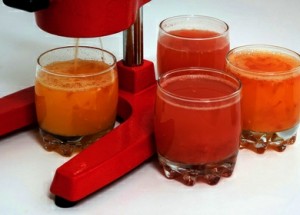
So, you are all set up to make your first cup of fresh, organic juice, and you are bursting with confidence…. that is until you take your first sip. Yuck… you wonder if it should really taste this bad, and quickly deduce that something has gone terribly wrong with the process.
While juicing is a great way to combine nutrient-dense foods into a one-glass meal, it is not quite as easy as just tossing a bunch of stuff together and flipping a switch. In order to make healthy and great tasting juice, there are a few essential ground rules to follow.
The Right Balance
Overzealous juicing newbies may be tempted to toss in a load of fruits and veggies that are high in natural sugar or fructose. Most carbohydrates that we eat are made up of chains of glucose that enter the bloodstream and are regulated by insulin. When we consume too much fructose, it floods the liver and the liver cannot process it fast enough for the body to use.
Because of this, the liver turns the fructose into fats that become dangerous triglycerides in the bloodstream. So, we may throw in a bunch of carrots, apples, oranges and maybe a few greens thinking that our juice is going to be totally awesome. While it tastes great and gives us a huge burst of energy, this is quickly followed by a case of the “crankies” and lethargy.
We have just taken a fructose roller coaster ride and crashed. To avoid this, it is important to get the right mix of fruits and veggies. Add plenty of greens and just a touch of fruit for flavor. Use low-sugar veggies like cucumbers and celery to help gain balance. You will still enjoy the fresh and slightly sweet flavor of your juice, and instead of a quick burst of energy, you will feel vibrant and steady for a long time.
Drinking Too Much at One Time
Too much of something so healthy can’t be bad for you, right? Wrong … especially if you are new to juicing, it is important to start out slowly, letting your body get used to the flood of nutrients. Juicing is a form of highly concentrated nutrition. In fact, when you process a carrot through a juicer you get 90% more beta carotene than if you eat it raw.
So, when you are juicing, think of one raw carrot becoming ten. Health is all about achieving balance and drinking massive quantities of juice, no matter how good it is for you, can throw things out of whack pretty quickly. First time juicers should start with a couple of ounces of juice each day, gradually working up to 8 ounces.
People who consume prescription medications, or have certain medical conditions that could be affected by consuming a great deal of certain types of food at one time, should be extra careful with their juice consumption. Think about your juice as a multivitamin of sorts, you would not open your mouth and eat a whole jar of vitamins, would you?
Overmixing
It is really easy to just sort of toss all kinds of herbs, fruits and veggies into your juicer and hit the switch without much thought on how the flavors will mingle together. You can easily waste a lot of ingredients if you don’t put much forethought into it.
 As confusing as your recipe is, it may taste equally confusing when it is all mixed together. It is paramount that you use a little self restraint to keep yourself from throwing everything but the kitchen sink into your juicer.
As confusing as your recipe is, it may taste equally confusing when it is all mixed together. It is paramount that you use a little self restraint to keep yourself from throwing everything but the kitchen sink into your juicer.
Here are some delicious and healthy combinations to consider:
Great Green Mix
- Celery
- Kale
- Apple
- Parsley
- Lime
- Lemon
- Ginger
Cleanser and Antioxidant Mix
- Beets
- Apples
- Blackberries
- Ginger
Digestive Mix
- Parsley
- Spinach
- Watercress
- Ginger
-The Alternative Daily

